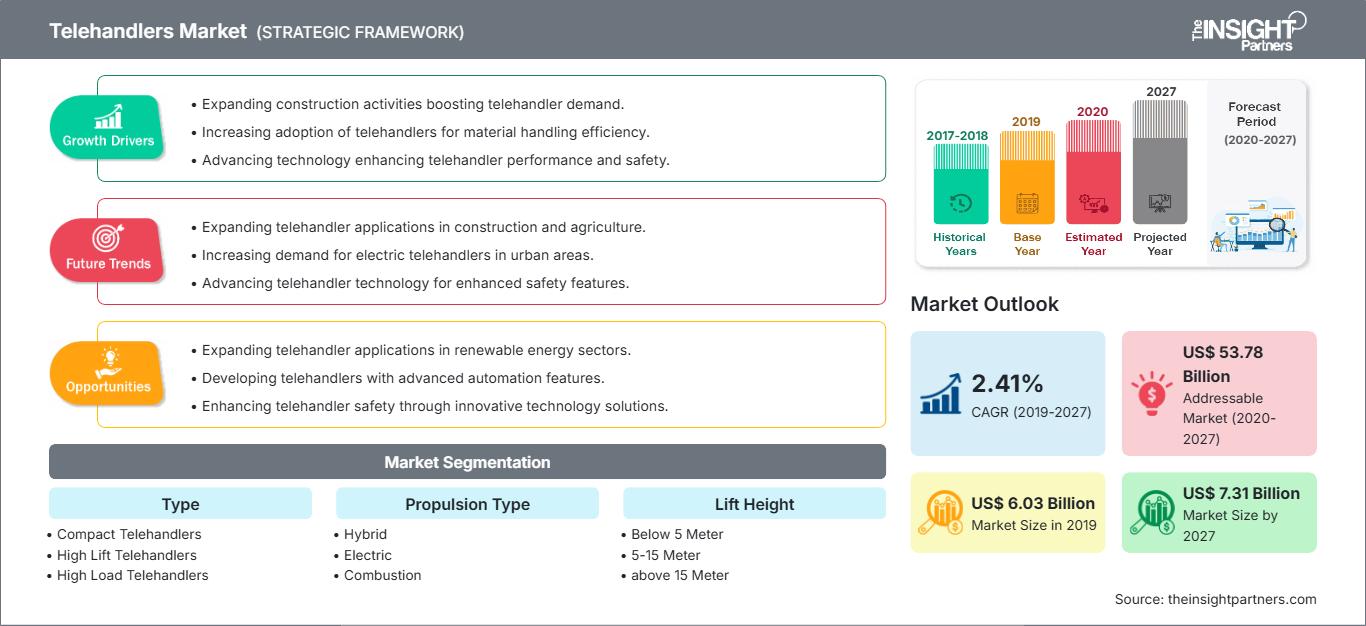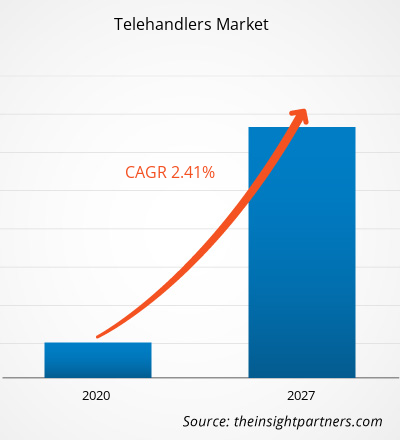[研究报告]2019 年伸缩臂叉装机市场价值为 60.3 亿美元,预计 2020 年至 2027 年的复合年增长率为 2.41%,到 2027 年将达到 73.1 亿美元。
过去几年,全球伸缩臂叉装机市场经历了显著增长。采矿、农业和基础设施项目的增加等因素推动了全球对包括伸缩臂叉装机在内的建筑设备的需求。此外,智能技术的出现和电动伸缩臂叉装机的推出。除建筑业外,农业在刺激市场对伸缩臂叉装机的需求方面也发挥着至关重要的作用。美国、中国、印度和巴西是从事农业活动的主要国家。伸缩臂叉装机是一种用于采矿、林业、建筑和农业等不同行业的机械设备。伸缩臂叉装机在北美和欧洲市场应用广泛,但在亚洲市场却并未得到广泛采用。在亚洲,人们使用其他替代机械,例如小型起重机。相反,亚洲国家的经济状况持续增长,这可能为伸缩臂叉装机供应商提供一个平台,使其能够在尚未开发的新兴经济体中拓展市场。
市场洞察:不断增长的采矿和建筑业务
中国等国家基础设施建设驱动的增长带来了经济的高速增长,并带动了对铁矿石、煤炭、锰、钴和铜等大宗商品的需求增长。对必要矿产和金属的勘探活动对采矿业的整体增长至关重要。此外,基础设施项目的增加和城市工业的发展也刺激了建筑行业对建筑设备的需求。随着全球基础设施项目的不断增加,对集成先进技术的设备的需求也在增长,以确保更高的生产力水平。
由于上述因素,伸缩臂叉装机市场预计将增长。
自定义此报告以满足您的要求
您将免费获得任何报告的定制,包括本报告的部分内容,或国家级分析、Excel 数据包,以及为初创企业和大学提供超值优惠和折扣
伸缩臂叉车市场: 战略洞察

- 获取本报告的主要市场趋势。这个免费样本将包括数据分析,从市场趋势到估计和预测。
Covid-19 对伸缩臂叉车市场的影响:
您将免费获得任何报告的定制,包括本报告的部分内容,或国家级分析、Excel 数据包,以及为初创企业和大学提供超值优惠和折扣
伸缩臂叉车市场: 战略洞察

- 获取本报告的主要市场趋势。这个免费样本将包括数据分析,从市场趋势到估计和预测。
2019-20 年 COVID-19(冠状病毒)疫情对社会、公共卫生和整体经济产生了重大影响。此外,它还给建筑、制造和采矿等众多行业带来了混乱。为了阻止病毒传播,一些公司正在采取措施,确保员工的安全和健康。在 Covid-19 疫情期间,建筑项目被搁置。此外,制造业也因封锁而关闭了其工厂。例如,JLG Industries 已暂停在美国和法国的生产,而在中国和罗马尼亚,工厂仍在有限劳动力的情况下运营。停工或低产能生产是进一步影响相关终端用户行业(如建筑行业)业务发展的主要因素,并最终将影响伸缩臂叉装机的普及。
类型洞察
根据类型,伸缩臂叉装机市场细分为紧凑型伸缩臂叉装机、高举升伸缩臂叉装机和高负载伸缩臂叉装机。高举升伸缩臂叉装机在全球伸缩臂叉装机市场中占据主导地位。全球日益增长的建筑和采矿活动要求部署高举升伸缩臂叉装机,以便通过将重物提升到很高的高度来简化其整体运营。这些伸缩臂叉装机也用于建筑、制造、仓储、采矿和采石等行业。
推进类型洞察
按推进类型,伸缩臂叉装机市场细分为混合动力、内燃机和电动。内燃机在全球伸缩臂叉装机市场中占据主导地位。伸缩臂叉装机使用内燃机,可使用汽油、液化石油气 (LPG)、柴油和压缩天然气等多种燃料。
起重能力洞察
根据起重能力,伸缩臂叉装机市场细分为 3 吨以下、3 - 10 吨和 10 吨以上。3 - 10 吨细分市场在全球伸缩臂叉装机市场中占据主导地位。由于 RFID 系统可自动识别动态负载图表的创建,伸缩臂叉装机可与各种配件完美兼容,从而满足制造和建筑行业的众多需求。
起重高度洞察
根据起重高度,伸缩臂叉装机市场细分为 5 米以下、5 - 15 米和 15 米以上。5 - 15 米细分市场在全球伸缩臂叉装机市场中占据主导地位。高度在5至15米之间的伸缩臂叉装机旨在提供最高水平的生产力和性能,同时兼具经济的运行成本、令人羡慕的多功能性、世界一流的制造质量以及丰富的附件选择。
最终用户洞察
按最终用户划分,伸缩臂叉装机市场可细分为建筑、农业、采矿、林业等。建筑行业在全球伸缩臂叉装机市场中占据主导地位。随着全球医疗保健、社会和教育基础设施建设的蓬勃发展,建筑行业对伸缩臂叉装机的需求也日益增长。
企业通常采用市场主动性和新的发展战略来扩大其全球影响力并满足日益增长的需求。这些战略主要在北美和欧洲实施。伸缩臂叉装机市场的参与者采用扩张和投资研发的战略,以扩大全球客户群,这也使得参与者能够在全球范围内维护其品牌。
伸缩臂叉装机市场区域洞察
The Insight Partners 的分析师已详尽阐述了预测期内影响伸缩臂叉车市场的区域趋势和因素。本节还讨论了北美、欧洲、亚太地区、中东和非洲以及南美和中美洲的伸缩臂叉车市场细分和地域分布。
伸缩臂叉车市场报告范围
| 报告属性 | 细节 |
|---|---|
| 市场规模 2019 | US$ 6.03 Billion |
| 市场规模 2027 | US$ 7.31 Billion |
| 全球复合年增长率 (2019 - 2027) | 2.41% |
| 历史数据 | 2017-2018 |
| 预测期 | 2020-2027 |
| 涵盖的领域 |
By 类型
|
| 覆盖地区和国家 | 北美
|
| 市场领导者和主要公司简介 |
|
伸缩臂叉装机市场参与者密度:了解其对业务动态的影响
伸缩臂叉装机市场正在快速增长,这得益于终端用户需求的不断增长,而这些需求的驱动因素包括消费者偏好的不断变化、技术进步以及对产品优势的认知度不断提高。随着需求的增长,企业正在扩展产品线,不断创新以满足消费者需求,并抓住新兴趋势,从而进一步推动市场增长。

- 获取 伸缩臂叉车市场 主要参与者概述
- 紧凑型伸缩臂叉车
- 高举升伸缩臂叉车
- 高负载伸缩臂叉车
全球伸缩臂叉车市场 - 按推进类型
- 混合动力
- 内燃机
- 电动
全球伸缩臂叉车市场 - 按提升高度
- 5 米以下
- 5 - 15 米
- 15 米以上
全球伸缩臂叉车市场 - 按提升能力
- 3 吨以下
- 3 - 10 吨
- 10 吨以上
全球伸缩臂叉车市场 -
- 建筑
- 农业
- 采矿
- 林业
- 其他
伸缩臂叉装机市场 - 按地域
北美
- 美国
- 加拿大
- 墨西哥
欧洲
- 法国
- 德国
- 意大利
- 英国
- 俄罗斯
- 欧洲其他地区
亚太地区
- 中国
- 印度
- 澳大利亚
- 韩国
- 日本
- 亚太其他地区
中东和非洲
- 南非
- 沙特阿拉伯
- 阿联酋
- 中东和非洲其他地区
南美洲
- 巴西
- 阿根廷
- 南美洲其他地区
公司公司简介
- AB沃尔沃
- 山猫公司
- 卡特彼勒公司
- CNH Industrial NV
- Hauloutte Group
- JLG Industries, Inc.
- 小松有限公司
- 利勃海尔集团
- 曼尼通BF
- 特雷克斯公司
- 历史分析(2 年)、基准年、预测(7 年)及复合年增长率
- PEST和SWOT分析
- 市场规模、价值/数量 - 全球、区域、国家
- 行业和竞争格局
- Excel 数据集
近期报告
客户评价
购买理由
- 明智的决策
- 了解市场动态
- 竞争分析
- 客户洞察
- 市场预测
- 风险规避
- 战略规划
- 投资论证
- 识别新兴市场
- 优化营销策略
- 提升运营效率
- 顺应监管趋势






















 获取免费样品 - 伸缩臂叉车市场
获取免费样品 - 伸缩臂叉车市场